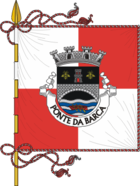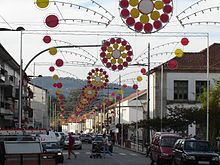Ponte da Barca
| Ponte da Barca | ||||||
|---|---|---|---|---|---|---|
|
||||||
| Basic data | ||||||
| Region : | Norte | |||||
| Sub-region : | Alto Minho | |||||
| District : | Viana do Castelo | |||||
| Concelho : | Ponte da Barca | |||||
| Coordinates : | 41 ° 49 ′ N , 8 ° 25 ′ W | |||||
| Residents: | 12,061 (as of June 30, 2011) | |||||
| Surface: | 182.11 km² (as of January 1, 2010) | |||||
| Population density : | 66 inhabitants per km² | |||||
| Ponte da Barca district | ||||||
|
||||||
| Residents: | 12,061 (as of June 30, 2011) | |||||
| Surface: | 182.11 km² (as of January 1, 2010) | |||||
| Population density : | 66 inhabitants per km² | |||||
| Number of municipalities : | 17th | |||||
| administration | ||||||
| Administration address: | Câmara Municipal de Ponte da Barca Praça da República 4980-626 Ponte da Barca |
|||||
| President of the Câmara Municipal: | António Vassalo Abreu ( PS ) | |||||
| Website: | www.cmpb.pt | |||||
Ponte da Barca is a small town ( vila ) and a district ( concelho ) in northern Portugal on the Rio Lima near the Spanish border. 12,061 people live in the district (as of June 30, 2011).
geography
Located on the left side of the Rio Lima, the place is 72 km north of the city of Porto , and 40 km east of the district capital Viana do Castelo .
history
Various finds and excavations prove a prehistoric settlement, including remains of dolmens and ramparts of the Castro culture . In 1979 rock engravings were discovered in the municipality of Lindoso .
After the campaign of conquest in 137 BC BC of Decimus Junius Brutus Callaicus , the area became Roman. Coins, ceramics, and sculptures have been found from this period, and a bridge has been preserved. The Roman administrative area known as Anobrega existed as Terra de Nóbrega until the Middle Ages. Theresa of Castile gave it first city rights ( Foral ) in 1125 .
In the years following the independence of the Kingdom of Portugal (from 1139 ) also came increasingly pilgrims on their way to Santiago de Compostela by. They had to cross the river in a ferry boat ( Portuguese : Barca ). In 1220 the first mention of a town called Barca in the Terra de Nóbrega district . From 1386 the place was known as Ponte da Barca , after a bridge had been built over the Lima here in previous years, and it became the seat of the Terra da Nóbrega district , which later got its name. In 1513 King Manuel I gave Ponte da Barca its first Portuguese town charter ( Foral ).
Culture and sights
The Ponte da Barca district is partly located in the Peneda-Gerês National Park . Hiking trails are laid out, and river pools offer bathing opportunities.
The architectural monuments of the place include mansions , historical public buildings, stone fountains, a Roman and a late medieval bridge as well as a number of sacred buildings , including the single-nave Mannerist - Baroque main church Igreja Matriz de Ponte da Barca (also Igreja de São João Baptista ) from the 16th Century. The historic town center as a whole is also a listed building.
One of the archaeological sites in the district is the statue menhir of Ermida in the local museum of Ermida.
Places of culture include the chess association CXAM - Clube de Xadrez do Alto Minho , the city archives ( Arquivo Municipal ), the municipal event center Auditório Municipal - Casa de Santo António do Buraquinho , the exhibition and sales center for regional products ( Centro de Exposição e Venda de Produtos Regionais ), the quartz crystal museum Museu de Cristais de Quartzo in Vila Chã (Santiago) as well as the historical-archaeological museums in Ermida and in the castle of Lindoso .
Every year on the last weekend in July, the town takes place with the Festival Folk Celta de Ponte da Barca, a music festival for Celtic- inspired music, which is accompanied by an alternative market , including international folk dance performances , stands, and acupuncture , yoga , Reiki and various massage offers . Musicians announced in 2013 include Irish violinist Niamh Ni Charra and pianist and bagpipe player Cristina Pato from Galicia .
administration
circle
The Ponte da Barca district borders on Spain to the east . The neighboring areas are (starting clockwise in the north): Arcos de Valdevez , Terras de Bouro , Vila Verde and Ponte de Lima .
With the regional reform in September 2013 , several municipalities were merged into new municipalities, so that the number of municipalities decreased from 25 to 17.
The following municipalities ( freguesias ) are in the Ponte da Barca district:
| local community | Population (2011) |
Area km² |
Density of population / km² |
LAU code |
|---|---|---|---|---|
| Azias | 377 | 8.44 | 45 | 160601 |
| Boivães | 289 | 3.53 | 82 | 160602 |
| Bravães | 629 | 4.17 | 151 | 160603 |
| Britelo | 485 | 12.90 | 38 | 160604 |
| Crasto, Ruivos e Grovelas | 882 | 9.92 | 89 | 160626 |
| Cuide de Vila Verde | 344 | 3.82 | 90 | 160606 |
| Entre Ambos-os-Rios, Ermida e Germil | 612 | 38.67 | 16 | 160627 |
| Lavradas | 875 | 6.76 | 130 | 160611 |
| Lindoso | 427 | 46.03 | 9 | 160612 |
| Nogueira | 410 | 1.99 | 206 | 160613 |
| Oleiros | 466 | 3.41 | 137 | 160614 |
| Ponte da Barca, Vila Nova de Muía e Paço Vedro de Magalhães | 4,372 | 8.84 | 495 | 160628 |
| Sampriz | 342 | 6.56 | 52 | 160619 |
| Touvedo (São Lourenço e Salvador) | 377 | 6.09 | 62 | 160629 |
| Vade (S. Pedro) | 264 | 2.65 | 99 | 160623 |
| Vade (S. Tomé) | 287 | 1.57 | 183 | 160624 |
| Vila Chã (São João Baptista e Santiago) | 623 | 16.76 | 37 | 160630 |
| Ponte da Barca district | 12,061 | 182.11 | 66 | 1606 |
Population development
| Population in Ponte da Barca county (1801–2011) | ||||||||||
|---|---|---|---|---|---|---|---|---|---|---|
| 1801 | 1849 | 1900 | 1930 | 1960 | 1981 | 1991 | 2001 | 2011 | ||
| 10,543 | 9488 | 12,962 | 13,634 | 16,265 | 13,999 | 13,142 | 12,909 | 12,061 | ||
Municipal holiday
- August 24th
Town twinning
-
 France : Les Clayes-sous-Bois in the Yvelines department (since 2003)
France : Les Clayes-sous-Bois in the Yvelines department (since 2003)
economy
The district is dominated by agriculture, livestock farming is one of the focal points. The local wine is known, especially the Vinho Verde . The industry is mainly represented here with wood processing companies and companies in the food industry, dairy products in particular.
traffic
Ponte da Barca is the end of the A27 motorway coming from Viana do Castelo . The national road N101 crosses the village and connects to the A27.
Various private bus companies offer regional and national bus connections.
Sons and daughters
- Diogo Bernardes (1530-1605), poet
- Agostinho da Cruz (1540–1619), monk and poet
- João Pimenta de Abreu († 1632), Bishop of the Azores
- Thomaz Xavier Ferreira de Menezes (1818–1891), building contractor in Brazil, ancestor of Helô Pinheiro , the Girl from Ipanema
- Casimiro D'Ascensão de Sousa e Menezes (1834–1910), engineer and philosopher
- Manuel Bento de Sousa (1835–1899), doctor and author
- Júlio Cardoso (* 1938), actor and theater director
- Rosa do Canto (born 1953), actress
- Leonor Carneiro (* 1978), track and field athlete
gallery
- Some impressions from the communities of Ponte da Barca
Gate with drawbridge to Castelo do Lindoso
Reservoir of the Rio Lima near Lindoso, view from the Castelo in north direction. In the mountains: the Spanish border town of Olelas
Web links
- Map of the Ponte da Barca district at the Instituto Geográfico do Exército
- Official website
Individual evidence
- ↑ a b c www.ine.pt - indicator resident population by place of residence and sex; Decennial in the database of the Instituto Nacional de Estatística
- ↑ a b Overview of code assignments from Freguesias on epp.eurostat.ec.europa.eu
- ↑ Entry of the place in the online lexicon "Infopédia" of the Porto Editora , accessed on March 5, 2013
- ↑ www.monumentos.pt (under “Cronologia”), accessed on March 5, 2013
- ^ João Fonseca: Dicionário do Nome das Terras. 2nd edition, Casa das Letras, Cruz Quebrada 2007, p. 205 ( ISBN 978-9724617305 )
- ↑ www.verportugal.net , accessed March 5, 2013
- ↑ www.monumentos.pt , accessed on March 5, 2013
- ↑ ditto
- ↑ www.cmpb.pt , accessed March 5, 2013
- ↑ www.verportugal.net , accessed March 5, 2013
- ^ Publication of the administrative reorganization in the Diário da República gazette of January 28, 2013, accessed on March 16, 2014
- ↑ www.anmp.pt , accessed March 5, 2013
- ↑ Ponte da Barca entry in the online lexicon "Infopédia" of the Porto Editora , accessed on March 5, 2013
- ↑ www.cmpb.pt (PDF; 17 kB), accessed on March 5, 2013

















